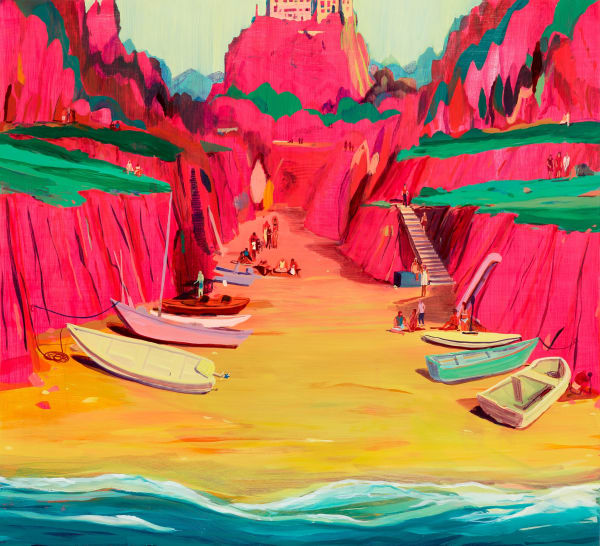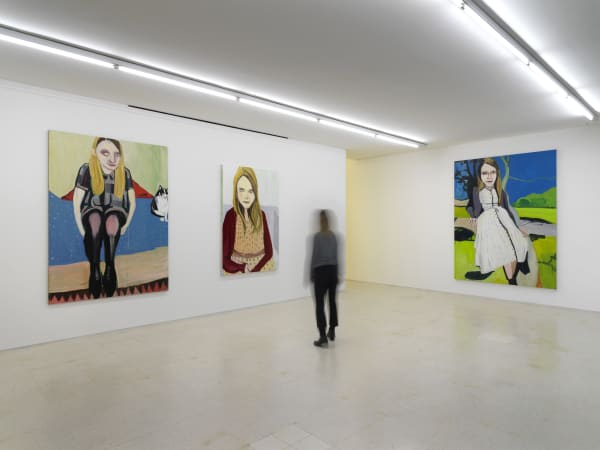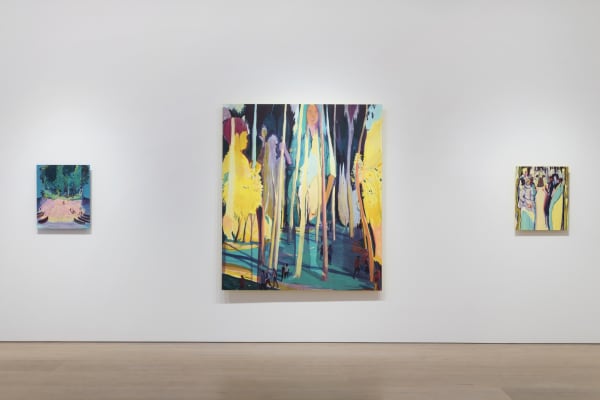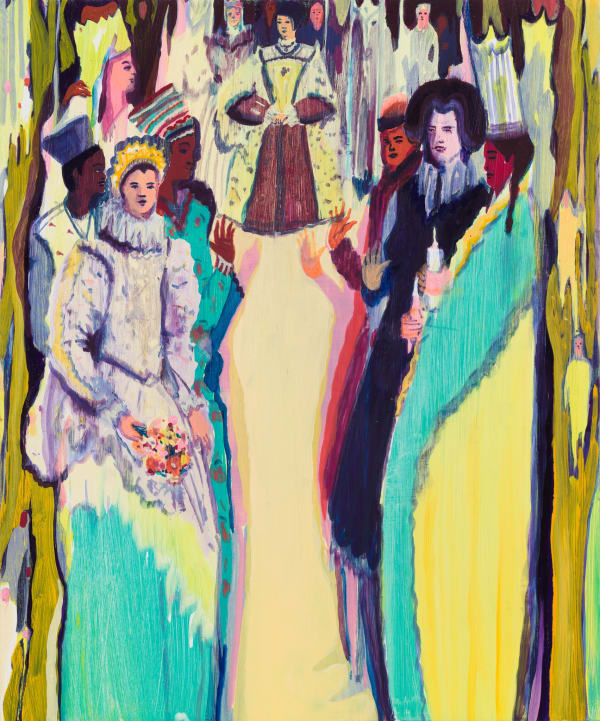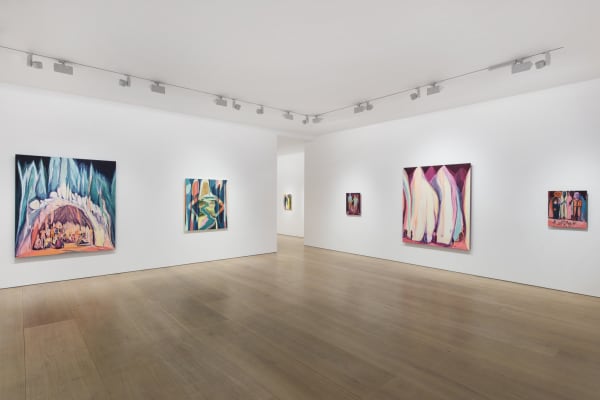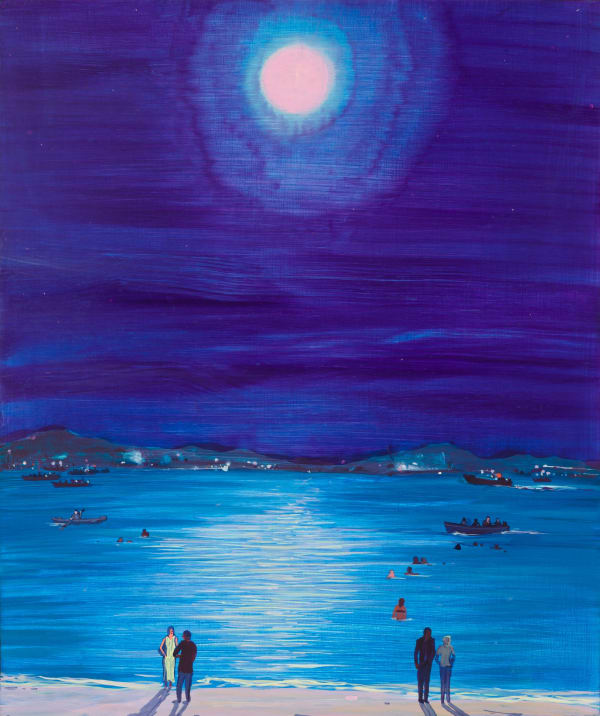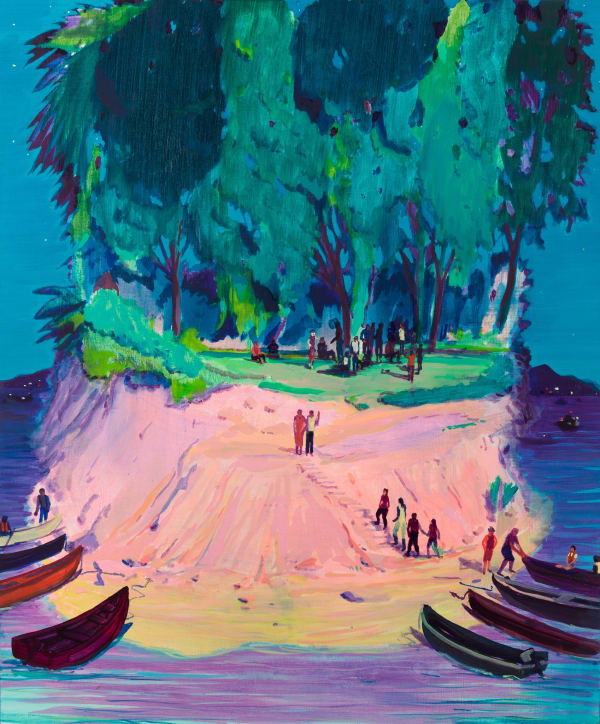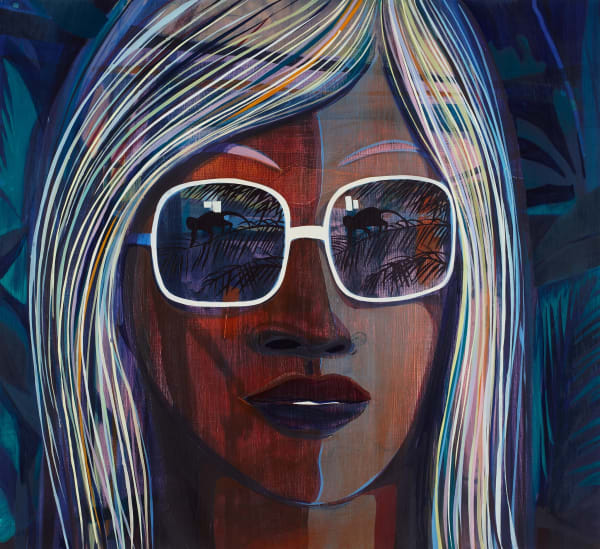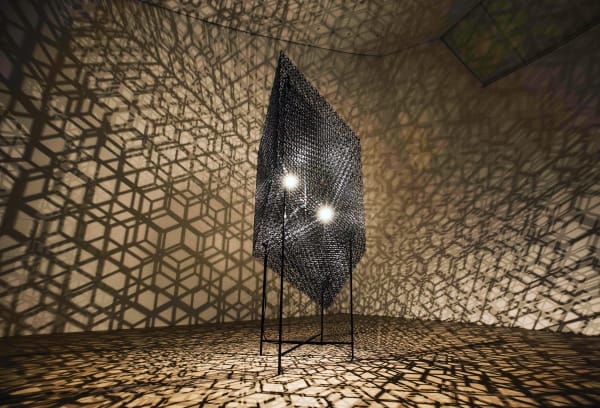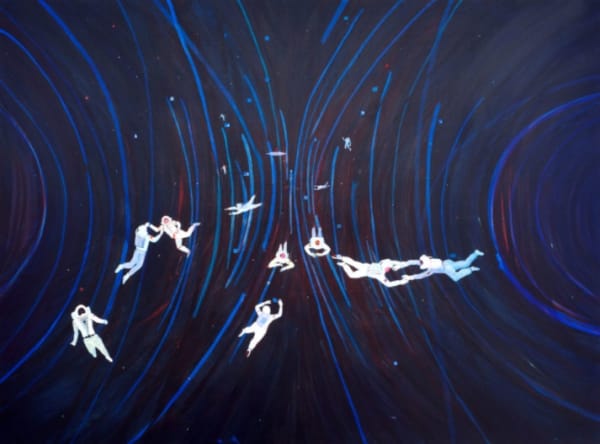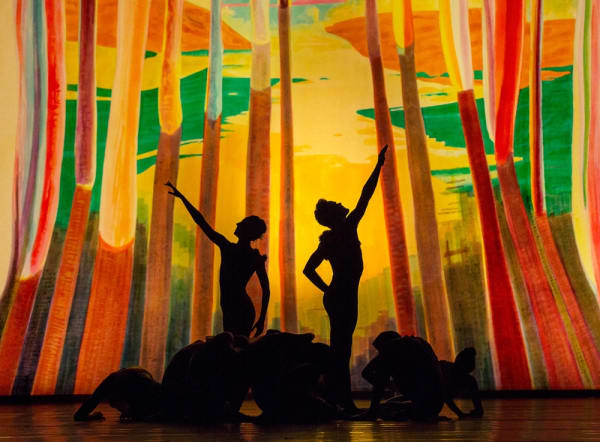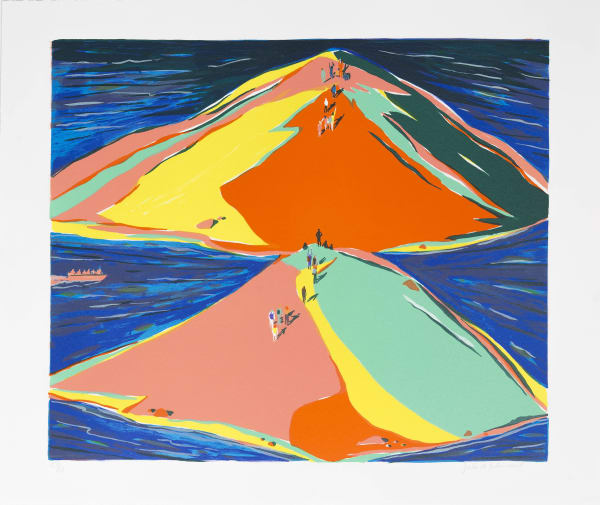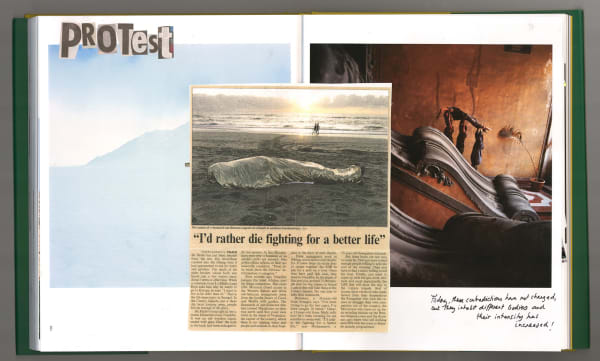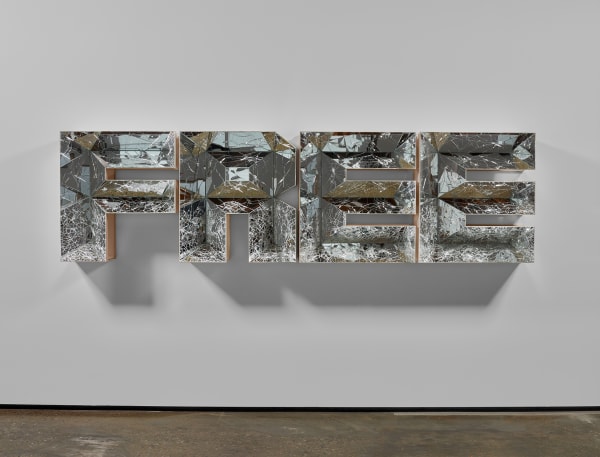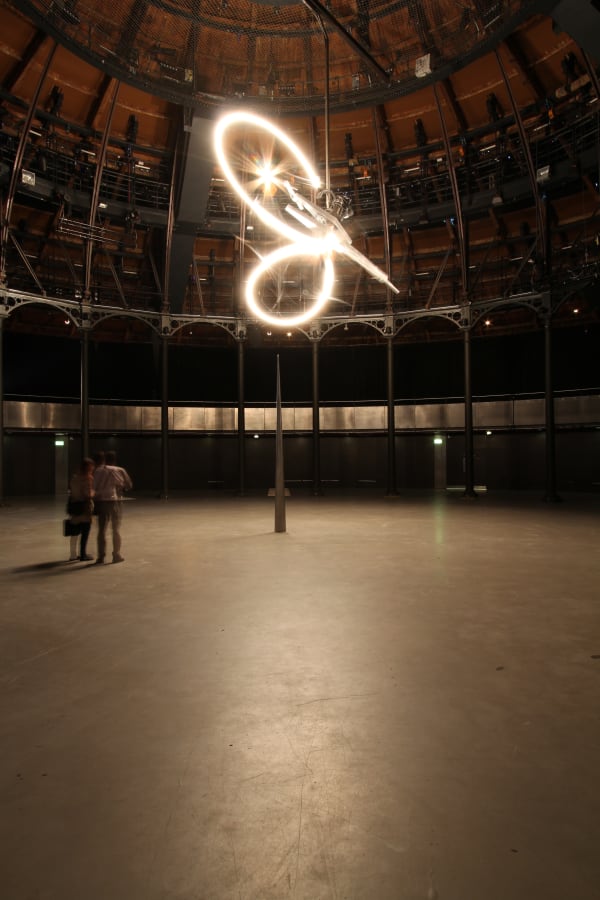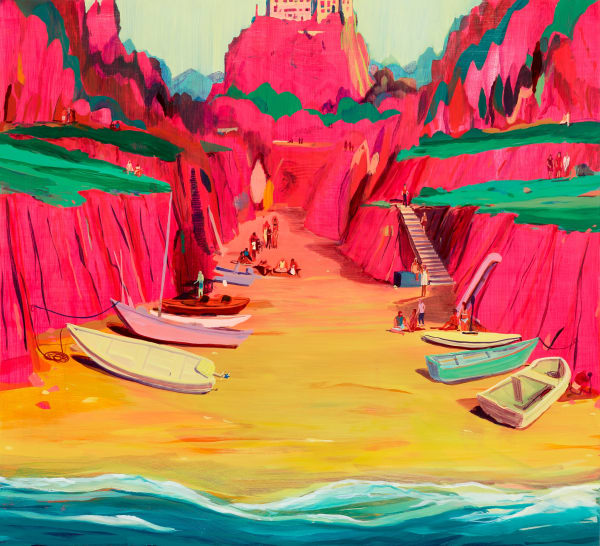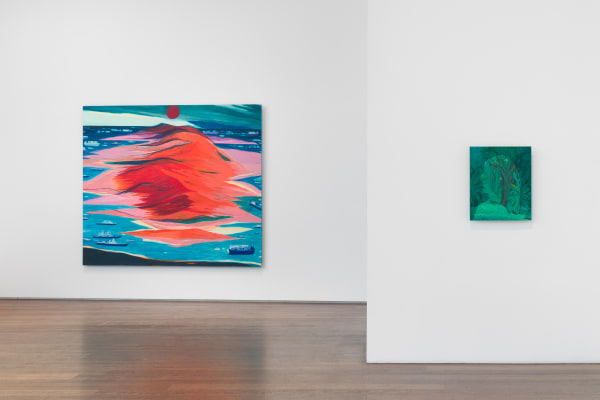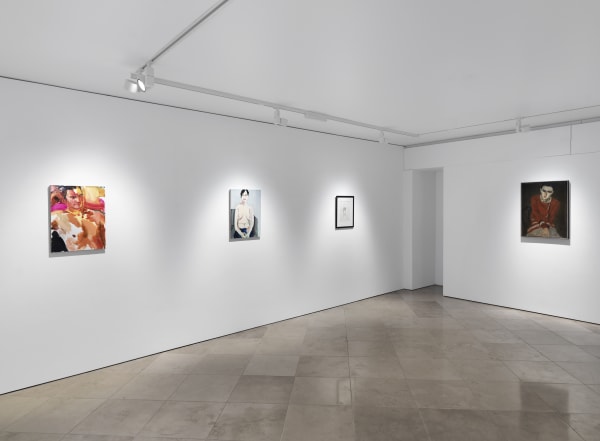Jules de Balincourt
-
About
Jules de Balincourt's paintings are states of mind rather than descriptions of the world around us. The Brooklyn-based artist explores painting as an intuitive process, resulting in fantasy-like worlds in which landscapes and seascapes interplay with more abstract works.
In de Balincourt's paintings land and sea become sites of possibility and escape, while also containing elements of mysterious unease. Rather than rely on sketch, photography, or direct reference, the artist's process initially involves him building up many translucent layers of paint, working from abstraction into a figurative depiction. In these ambiguous, evocative spaces, where figures seem to be in perpetual motion, one senses the movement of an ever-changing, volatile world. At times, landscapes and figures start to break down into more abstract imagery, retaining figurative elements that allude to meditation or escape from our reality. Often, large and small paintings co-exist, sometimes arranged in a salon-style installation, leaving the viewer to free-associate between the images on view.
-
Biography
Jules de Balincourt, born in Paris, France in 1972, lives and works in Brooklyn, New York.
De Balincourt’s work has been the subject of a number of international solo exhibitions at institutions including Centro de Arte Contemporáneo, Málaga, Spain (2021); Kasseler Kunstverein, Kassel, Germany (2015); The Modern Art Museum of Fort Worth, Texas, USA (2014–15); Rochechouart Museum of Contemporary Art, Rochechouart, France (2014); Montreal Museum of Fine Arts, Montreal, USA (2013); Mori Art Museum, Tokyo, Japan (2010) and Vanderbilt University Fine Arts Gallery, Nashville, USA (2008).
De Balincourt’s work has also been included in a number of significant group exhibitions, including Unnatural Nature: Post-Pop Landscapes, Acquavella Galleries, Florida, USA (2022); Rehang, Collezione Maramotti, Reggio Emilia, Italy (2019); Les Enfants du Paradis, MUba Eugene Leroy Tourcoing, France (2019) and Eldorama, Le Tripostal, Lille, France (2019) both as part of Eldorado: Lille 3000 (2019); The Biennial of Painting, Museum Dhondt-Dhaenens (MDD), Deurle, Belgium (2018); The New Frontiers of Painting, Fondazione Stelline, Milan, Italy (2017); The Universe and Art, Mori Art Museum, Tokyo, Japan (2016); L’Ange de l’Histoire, curated by Nicolas Bourriaud at le Palais des Beaux-Arts, Paris, France (2013); New York Minute, Garage Center for Contemporary Culture, Moscow, Russia (2011) and the 10th Havana Biennial, Museo Nacional de Bellas Artes, Havana, Cuba (2009).
Works by the artist are included in the collections of Brooklyn Museum, Brooklyn, New York, USA; Collezione Maramotti, Reggio Emilia, Italy; Los Angeles County Museum of Art, Los Angeles, USA; MaRT, Museo di arte moderna e contemporanea di Trento e Rovereto, Rovereto, Italy; Montreal Museum of Fine Arts, Montreal, Canada; Musée départemental d’art contemporain de Rochechouart, Rochechouart, France; Museum of Contemporary Art, Los Angeles, CA, USA; Portland Art Museum, Portland, ME, USA, among others.
-
News
-

Jules de Balincourt – After the Gold Rush at CAC Málaga
March 12, 2021The exhibition (12 March–30 May 2021) features more than forty paintings created over the past decade. Recent paintings by the artist continue an intuitive approach...Read More -

Collezione Maramotti opens its rehung galleries, featuring displays by Jules de Balincourt and Chantal Joffe
March 3, 2019For the first time since the opening of Collezione Maramotti in October 2007, ten rooms on the second floor of the permanent display have been...Read More -

Jules de Balincourt talks to Floorr Magazine about his exhibition at Victoria Miro Mayfair
February 15, 2018Could you tell us a bit about yourself and your background. Where did you study? I was born in Paris France in 1972 and between...Read More -

Elephant Magazine interviews Jules de Balincourt about his Victoria Miro Mayfair exhibition
February 7, 2018By Emily Spicer “I rarely make paintings with a set, initial plan. They start as abstract forms and it becomes this intuitive, primitive, dance—a dance...Read More -

Jules de Balincourt discusses his current exhibition, They Cast Long Shadows, in the Guardian
February 6, 2018Denounced monuments, moonlit peace-seekers, how Brexit looks to Americans … Jules de Balincourt’s vivid, dreamlike works capture his country’s divisive times 'In America, the women’s...Read More -

Jules de Balincourt talks to Port Magazine about his exhibition, They Cast Long Shadows, at Victoria Miro Mayfair
January 31, 2018Franco-American painter Jules de Balincourt ruminates on abstraction, utopia and the accessibility of art, at the opening of his latest exhibition By Jo Lawson-Tancred If...Read More -

Candid Magazine reviews Jules de Balincourt: They Cast Long Shadows
January 25, 2018By Claire Philips “You know that place between sleep and awake, that place where you still remember dreaming?” (- J.M. Barrie Peter Pan) That’s the...Read More -

Jules de Balincourt: They Cast Long Shadows featured in The Telegraph’s The Critical List
January 13, 2018'The New York-based French artist's multi-layered paintings blur the boundaries of fantasy and reality with sumptuous colour.' Read more Image: Jules de Balincourt, They Were...Read More -

Jackie Wullschlager selects Jules de Balincourt: They Cast Long Shadows in FT Critics’ Choice
January 13, 2018''They Cast Long Shadows' is the title the French-American painter gives to his latest dystopian imaginings: a group of acid-bright, glowing, shifting forms, pushed to...Read More -

Jules de Balincourt in conversation with Marcel Dzama in the December issue of Juxtapoz Magazine
November 8, 2017Jules de Balincourt Searching the Wave of Possibility There’s the depth and scope, the sensational fields of vision in the paintings of Jules de Balincourt....Read More -

Conrad Shawcross and Jules de Balincourt in The Universe and Art at ArtScience Museum Singapore
April 15, 2017The Universe and Art is an artistic voyage through the cosmos, exploring where we came from and where we are going. It weaves a rich...Read More -

Channel News Asia previews The Universe and Art, featuring Jules de Balincourt and Conrad Shawcross
April 2, 2017Outer space, aliens, art: 3 reasons why ArtScience Museum’s new show is out of this world . By Mayo Martin SINGAPORE: In 1999, Slovenian director...Read More -

Jules de Balincourt creates the scenic design for New York City Ballet's production of Scherzo Fantastique
January 22, 2017Premieres January 22 as part of New York City Ballet's program Stravinsky x 5 Performances January 22, 24, 27, and February 3 2017 Set to...Read More -

Jules de Balincourt creates two new lithographs for Edition Copenhagen
October 23, 2016Just launched, the artist's first lithographs are available via the Edition Copenhagen website . Each work is in an edition of 60, numbered and signed...Read More -

Just out: Protest publication
September 23, 2016This publication accompanies Protest at Victoria Miro, 23 September - 5 November 2016, an exhibition of historical and contemporary works by artists concerned with the...Read More -

Power to... the art of protest, as featured in The Observer
September 23, 2016Politically engaged art is thriving again, finding new ways to challenge in a complex digital world. We look at the rich history of protest art...Read More -

Conrad Shawcross and Jules de Balincourt at Mori Art Museum, Tokyo
July 30, 2016The Universe and Art (until 9 Jan 2017) comprises around 200 objects, bringing meteorites and fossils, historic astronomical material by Da Vinci and Galileo, and...Read More -

Jules de Balincourt interviewed in Studio International
May 3, 2016The painter’s uncanny worlds reflect the post-9/11 zeitgeist with a beguiling charm. The world is a fragile, unsettling place, he says, and it’s difficult not...Read More -

Jules de Balincourt interviewed in The Telegraph
April 16, 2016The man who paints the good, the bad and the ugly of modern California. By Jonathan Griffin. In Jules de Balincourt's paintings, the romance of...Read More -

Jules de Balincourt: Itinerant Ones is reviewed in The Guardian
November 19, 2013Jules de Balincourt: the Hitchcock of the painting world. By Adrian Searle. The French artist's absorbing canvases create whole worlds, embrace the miracle of being...Read More
-
-
Gallery Exhibitions
-

Jules de Balincourt: Moving Landscapes
4 Oct – 2 Nov 2024 London Gallery IIIn this new body of work, the Brooklyn-based artist continues his exploration of painting as an intuitive process, resulting in fantasy-like worlds in which landscapes and seascapes become sites of possibility and escape.Learn More -

Unmasked
12 Feb – 27 Mar 2022 VeniceAn exhibition in Venice of works by Milton Avery, Jules de Balincourt, Hernan Bas, María Berrío, Chantal Joffe, Doron Langberg, Alice Neel and Celia Paul.Learn More -

The Sky was Blue the Sea was Blue and the Boy was Blue
24 Feb – 30 Apr 2021 Miro PresentsAn exhibition of work by 19 artists celebrating the colour blue, available online and on Vortic as part of The London Collective.Learn More -

Jules de Balincourt: They Cast Long Shadows
19 Jan – 24 Mar 2018 Victoria Miro MayfairQuiet, reflective and mysterious, new paintings by Brooklyn-based artist Jules de Balincourt continue an intuitive approach to image-making, where the world we inhabit is filtered through the artist’s own psychological...Learn More -

House Work
25 Jan – 18 Mar 2017 Victoria Miro MayfairIncluding Mamma Andersson, Jules de Balincourt, Hernan Bas, Marc Chagall, Peter Doig, Adrian Ghenie, David Harrison, Karen Kilimnik, John Kørner, LS Lowry, Alice Neel, Celia Paul, Grayson Perry, Tal R,...Learn More -

Protest
23 Sep – 5 Nov 2016 London Gallery IDoug Aitken, Jules de Balincourt, Vlassis Caniaris, Elmgreen & Dragset, Ian Hamilton Finlay, Christian Holstad, Isaac Julien, Yayoi Kusama, Wangechi Mutu, Alice Neel, Chris Ofili, Richard Prince, Sarah Sze, Wolfgang Tillmans, Rirkrit Tiravanija and Kara Walker.Learn More -

Jules de Balincourt: Stumbling Pioneers
14 Apr – 14 May 2016 London Gallery IPerched on the shores of the Pacific Ocean, Los Angeles has, since the pioneering age, been the limitless repository of America’s dreams of the frontier, of desires that saturate the...Learn More -

Jules de Balincourt: Itinerant Ones
16 Nov – 20 Dec 2013 London Gallery IThe first solo exhibition in the UK for the Paris-born, New York-based painter. Known for his carefully constructed paintings that move effortlessly between abstraction and figuration, the imagined and the...Learn More
-
-
Contact Form
Contact us regarding available works by Jules de Balincourt


